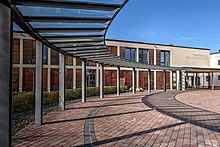Hedwig von Eberstein
Clara Hedwig von Eberstein (born November 2, 1817 in Schönefeld near Leipzig ; † October 10, 1900 there ) was a German manor owner and founder .
Life
Hedwig von Eberstein was the daughter of the Royal British Army Captain Franz Botho Freiherr von Eberstein († 1841), and his wife Marianne Wilhelmine Rosine Elisabeth Freifrau von Eberstein née Schneider (1792-1849), the heiress of the Schönefeld manor near Leipzig. As a child, she was treated with a stretching bed against a small curvature of the spine , which could not be removed.
Hedwig von Eberstein remained unmarried. Her passion was traveling. She gave some of the natural and ethnographic objects brought from all over the world as a gift to Leipzig museums during her lifetime. In 1849 she became the sole heir to the Schönefeld estate; her older sister Franziska Ulrike Marianne was already dead. In contrast to her predecessors, she did not appoint inspectors to manage the property, but from 1851 tenants . She was also supported by expert advisors.
During the Battle of the Nations near Leipzig in 1813, the castle belonging to the estate and built in 1604 by Georg Heinrich von Thümmel burned down and was not rebuilt until the 1860s. Hedwig von Eberstein's plan for the rebuilding, drawn up in 1871, was implemented in 1876 with the completion of a completely new castle building, which is still standing today.
In the course of Leipzig's expansion in and after the founding period , it sold large areas of the Schönefeld estate to the city of Leipzig, on which the initially independent communities of Neustadt and Neuschönefeld emerged, which were incorporated into Leipzig in 1890. The streets here were named after her or her mother as Hedwigstraße and Mariannenstraße . In her will, she stipulated that the area west of Lindenallee (today Schönefelder Allee) was not allowed to be built on, so that the Volkspark Schönefeld could be built here in 1913, which has been called Mariannenpark since 1931 , also named after her mother.
In 1883 Hedwig von Eberstein had a burial place in the form of a pyramid built for her own family and that of her mother by the Leipzig architect Constantin Lipsius (1832-1894) south of the Schönefeld church , which was bricked up after her burial.
Foundation, endowment
After a family dispute when a nephew refused her a loan intended for building purposes, Hedwig von Eberstein decided in 1881 to put all of her assets, manor, property and 805,000 marks into a foundation after her death. This foundation should be intended for the establishment and operation of a supply facility for the poor daughters of high civil service officials and the military in the castle. They had to be “over 30 years old (later 50), unmarried, healthy and blameless”, have no more than 6,000 marks of their own assets and their father had a fixed annual income of at least 4,500 marks. These ladies received free accommodation, full board and 600 marks annually in needle money in the castle . Candidates who could not find a place in the castle could receive ongoing allowance. The foundation was named "Mariannenstiftung" after Hedwig's mother.
In 1949 the foundation's property was expropriated and transferred to the city of Leipzig, which set up a retirement home in the castle. In 1972 a care station for severely and multiply disabled children was added. In 1990 the castle had to be closed due to dilapidation. After extensive restoration, the Schönefeld Castle School was opened in 1994 .
Web links
- Eberstein, Hedwig Freiin von. In: Leipzig Lexicon. Retrieved July 11, 2016 .
- Ute Tartz: Clara Hedwig von Eberstein. In: Women's personalities in Leipzig. Retrieved July 11, 2016 .
- Integration + promotion of people with disabilities. In: Schloss Schönefeld e. V. Accessed January 26, 2020 .
- The historical development of Leipzig-Schönefeld. In: Wir für Schönefeld eV. Retrieved on January 26, 2020 .
Individual evidence
- ↑ according to the Chronicle of Schönefeld Palace ( memento from March 4, 2016 in the Internet Archive ) on August 27, 1816
- ↑ Gina Klank, Gernot Griebsch: Lexicon of Leipzig street names. Verlag im Wissenschaftszentrum Leipzig, Leipzig 1995, ISBN 3-930433-09-5 , p. 101 and p. 143.
| personal data | |
|---|---|
| SURNAME | Eberstein, Hedwig von |
| ALTERNATIVE NAMES | Eberstein, Clara Hedwig von (full name) |
| BRIEF DESCRIPTION | German manor owner and founder |
| DATE OF BIRTH | November 2, 1817 |
| PLACE OF BIRTH | Schönefeld near Leipzig |
| DATE OF DEATH | October 10, 1900 |
| Place of death | Schönefeld near Leipzig |



